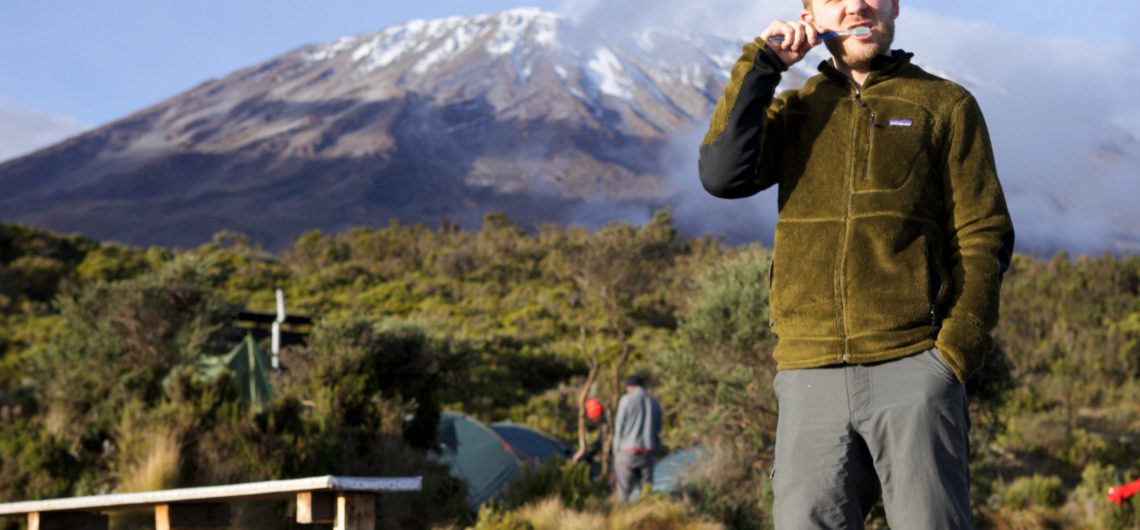Keeping clean when climbing Mount Kilimanjaro is an intriguing challenge. Showers are not accessible anywhere on the mountain unless you hike the Marangu route, which does provide cold showers. There will be no showering available for those of us ascending one of the other seven Kilimanjaro routes. As a result, we’ll all be a little stinkier than usual.
We recommend that you enjoy the break from hygiene while still keeping the worst at away by following these helpful hints:
- ‘bathing’
- nails
- hair
Prepare yourself to have to compromise your cleanliness standards a little throughout the journey, since showers are just not an option.
Bathing on Mount Kilimanjaro
Your mountain crew will give you a bowl of warm water and soap for washing your face and hands every evening in camp. This is referred to as ‘taking a passport.’ We recommend bringing a face towel with you for some extra cleaning power. If filth under your fingernails perplexes you, a little nailbrush could be useful.
If you have sensitive skin on your face, you should also carry some cleaning face wipes.
Don’t forget to bring a tiny microfibre towel to dry off with. If it has a loop or hook connected, that’s great since you can hang it up to dry in your tent.
Are there showers on Mount Kilimanjaro?
No, on Kilimanjaro, there are no showers. As a result, the last shower you take before your climb is the optimum time to properly scrub yourself. On Kilimanjaro, hygiene is restricted to water and any wipes or rags you have.
Every day, you will be given water to wash your hands and face. Otherwise, we recommend using baby wipes or other pre-moistened towelettes. They’re great for refreshing yourself after a long hike, in the morning, and before bed.
Nails Hygiene on Kilimanjaro
To minimize (too much) dirt getting under your nails, we recommend cutting them short immediately before starting the hike. Cleaning beneath your nails with a tiny scrubbing brush and a toothpick is also a good idea. If the sight of unclean nails terrifies you, we propose hiding the dirt with dark nail paint.
Hair Cleanliness on the Mountain
You’ll be up the mountain for more or less seven days and won’t be able to take a bath or shower. As a result, it’s a good idea to think about what you want to do with your hair ahead of time. Because everyone’s hair is different, we recommend devising a strategy based on what you know about your own.
Obviously, washing your hair right before heading to the mountain is a smart idea; that way, you’ll be set for the first couple of days. After that, consider plaiting longer hair to prevent dust from settling on it. Brushing it at night should assist to remove a little dust and any freeloaders, such as the occasional tiny leaf.
After that, it could only be a bandana, beanie, or cap to keep it covered. And that’s a good Kilimanjaro-style strategy. To keep the oiliness under control, we recommend using the headcover as well as a little baby powder or dry shampoo at the roots. If you have long hair, make sure your hair tie is strong, or that you have a backup band in case yours breaks or disappears.
When you are on your periods on Mount Kilimanjaro climbs
According to the International Climbing and Mountaineering Federation, changes in altitude, particularly a significant rise in height, might disrupt a woman’s menstrual cycle. As a result, hiking Mt Kilimanjaro might cause a variety of surprises,’ ranging from your period stopping earlier than normal to being early, irregular, or longer than usual. Basically, think about your period as a wildcard on a high-altitude trip. And this implies that any woman who has a period should be prepared to deal with it on the climb, even if you’re hiking during a time when you’re not supposed to have one.
NB: High altitude may affect your period in a variety of ways, so any woman who has a period should be psychologically and physically prepared to cope with it throughout the climb.
![]()


Comments